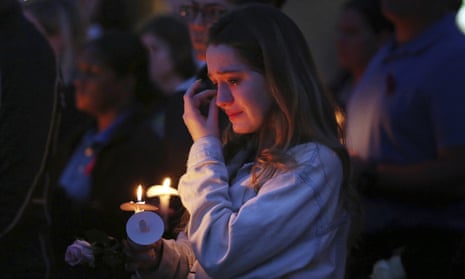The grim total includes more than 80 young musicians, 30 dancers, 40 community volunteers, at least 80 infants and toddlers and 40 college-bound seniors.
In the 12 months since the Parkland school shooting, nearly 1,200 American children and teenagers have been killed with guns.
The everyday killings of young Americans add up to “a Parkland every five days,” according to a new project from The Trace, a nonprofit that covers gun violence, in collaboration with McClatchy newspapers and the Miami Herald.
Fourteen high school students and three educators were murdered last Valentine’s Day at Marjory Stoneman Douglas high school in Parkland, Florida, a massacre that inspired a national youth protest movement for gun control.
SinceParkland.org, a new project from McClatchy and The Trace, attempts to tell the stories of every child and teenager, ages 18 and younger, killed with a gun since that shooting.
The profiles are simple and devastating. Peyton Nicole Hurt, 15, loved painting watercolors. She was shot to death by her ex-boyfriend at a house party in Kentucky. Sandra Parks, 13, who had just written an essay about preventing gun violence, was killed by a stray bullet in her bedroom in Wisconsin. Mikey Pacheco, 17, a varsity football player, was accidentally shot to death by one of his friends as they sat around his kitchen table in Massachusetts.
In Wilmington, Delaware, which has America’s highest rate of teen gun violence, two half-brothers were killed just blocks apart: Raquis Q Deburnure, 16, in May, Rashaad Izil Wisher, 18, in July.
In Chicago, James Garrett, 18, was shot to death at a vigil for a friend. He had been preparing to become a teacher. Two days later, 675 people came to a memorial service in his honor.
The project was designed as a response to young activists, including many Parkland students, who have criticized media outlets for not devoting enough attention to the toll of daily gun violence.
“Young people at the center of the movement really chided the press for only covering mass shootings and not going beyond that,” Akoto Ofori-Atta, managing editor at The Trace, and the project director of Since Parkland, said in an interview with MSNBC’s Stephanie Ruhle.
To write more than a thousand stories over the course of a year, The Trace recruited more than 200 teenage journalists from across the country.
“There’s no generation that has had to contend with this issue the way that young people today have had to contend with it,” Ofori-Atta said. “We felt it was their story to tell, and their perspective was needed.”
It was intense, emotional work. Some of the writers were the same age as the kids they were memorializing.
Trying to capture the life of King Thomas III, 15, who was killed during a home invasion in Texas, student journalist Kira Davis, also 15 at the time, listened to the music Thomas had posted on Soundcloud.
Joe Meyerson, a high school senior from Los Angeles, noted in a profile of the project that he was surprised and frustrated by how often news accounts of the shootings contained basic errors.
“These are young men, young women, and kids who have been gunned down,” Meyerson said. “How do you get their name wrong? How do you get where they lived wrong? How do you get their school wrong?”
Each obituary focuses on the lives and personalities of the kids lost, more than the circumstances of their deaths.
“These kids who died every day since Parkland, they were loved. They had full, complex lives,” Ofori-Atta said.
This count of 1,200 American kids killed with guns in the past year does not include gun suicides. An estimated 900 to 1,000 more children and teenagers killed themselves with guns in the past year, which would bring the total number of American youth gun deaths to more than 2,000 in a single year.
The majority of youth gun killings documented in the Since Parkland project are homicides. Only 154 of those killings were accidental, according to Caitlin Ostroff, a data reporter at McClatchy and the Miami Herald. The project relied on gun death data compiled by the Gun Violence Archive, a nonprofit that tracks shootings and gun deaths in real time using media reports. Journalists on the project also requested reports from hundreds of police agencies to verify the details of the incidents.
About 10% of the young people killed with guns were lost to domestic homicides. They were killed by their own relatives, their significant others, or their parents’ significant others. Many of the 133 domestic incidents were murder-suicides, including dozens of cases where mothers or fathers killed their children, and then killed themselves.
In one case, powerfully profiled in the Miami Herald, three young siblings were shot to death by their father, who then killed himself. Odin Tyler Painter, eight, was a Boy Scout. Cadence Nicole Painter, six, loved dancing. Drake Alexander Painter, four, preferred nature to screens, and liked to pick flowers for his mother, who was injured in the shooting, but survived.
